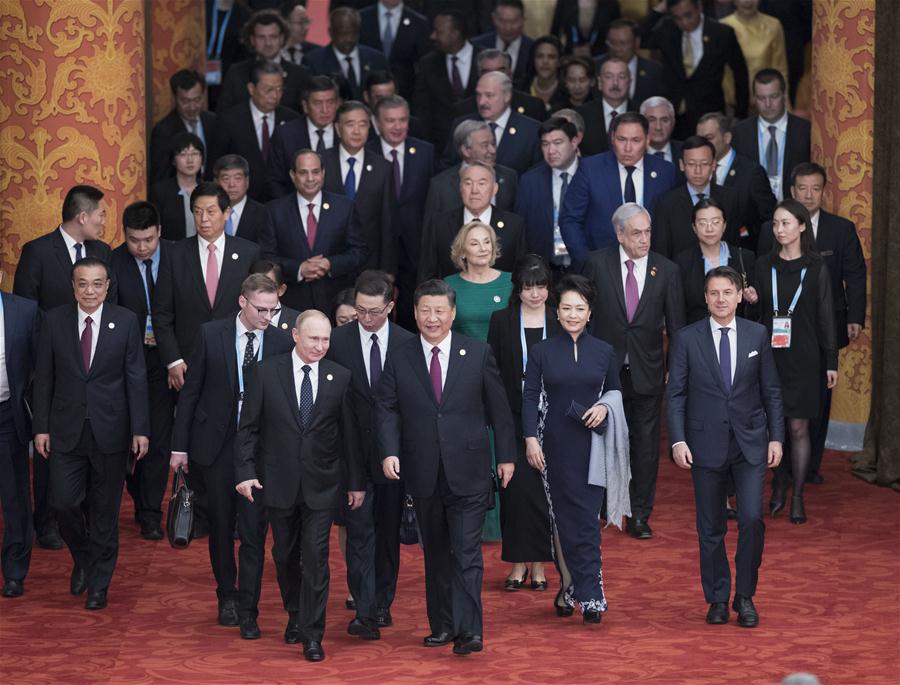
Chinese President Xi Jinping, his wife Peng Liyuan and guests of the Second Belt and Road Forum for International Cooperation attend a banquet in Beijing, capital of China, April 26, 2019.
The Second Belt and Road Forum for International Cooperation was held in Beijing at the end of April 2019. The event highlighted the extensive progress being made around the world on a variety of infrastructure projects since the official launch of the Belt and Road Initiative (BRI) in 2013. The Belt and Road Forum (BRF) is also significant in the BRI’s evolution as a way to provide the architecture for a formal, multilateral institution.
The BRI has typically been described as a cooperative arrangement amongst like-minded states interested in advancing infrastructure and connectivity projects around the world. As the breadth and depth of the BRI has grown in terms of the projects undertaken, the actors involved, and the objectives being pursued, the need for more formalized institutional architecture is clear.
The Second Forum produced a Joint Communique of Heads of States calling for increased cooperation and reaffirming that “strengthening multilateralism remains essential in addressing global challenges.” Chinese President Xi Jinping called for the Forum to become a regular event, suggesting that it will be used to implement a multilateral, institutional architecture for the BRI. Most significantly, the need for a more formal multilateral approach was promoted by the BRI’s Advisory Council.
The Advisory Council is a body set up after the First Forum describing itself as a “non-profit, international policy advisory body, offering intellectual support to the BRF.” The main functions of the Advisory Council include setting the themes and agenda for the Forum meetings, providing policy recommendations, fostering practical cooperation, and promoting further understanding of the BRI. In a report published in the run-up to the Second Forum, the Advisory Council set out three topics for discussion:
1) Synergy between the BRI and the 2030 Agenda for Sustainable Development in promoting world economic growth;
2) Priorities for the Belt and Road cooperation; and
3) Ways forward in strengthening the architecture and capacity building for the Belt and Road Cooperation.
All three points indicate that the BRI is moving towards enhanced multilateralism.
The move to create multilateral architecture for the BRI is inevitable. To date, most formal arrangements exist in the form of bilateral treaties or contracts on specific projects. Since the 2013 launch of the BRI, it has not been described as a formal organizational setup; rather, the BRI has been used as a descriptive label for a range of projects being undertaken around the world with China being involved in some way.
That is now changing, both by design and necessity. In the Final Communique of the Second Forum, the heads of state in attendance gave direct support for “strengthening multilateralism” as an essential part in addressing global challenges. Enhanced multilateral architecture is also needed for further cooperation in achieving agreed goals and objectives for the BRI such as ensuring support for the 2030 Agenda. On a practical level, multilateral architecture and cooperation is required to ensure connectivity projects are able to connect effectively across state borders, for achieving common standards and practices in the fields of tax regimes, environmental protection, economic activities, and anti-corruption — another stated objective of the BRI.
The Advisory Council Report directly addressed the issue of enhancing institutional architecture for the BRI. The report observes “there is a need for improved communication and better-coordinated collaboration among stakeholders, which in turn calls for more efficient and effective multilateral institutional support and capacity building for the Belt and Road cooperation.” It is suggested that the BRF become formalized to meet every 2-3 years to discuss and set the broad parameters of the BRI. From this there can also be “satellite events” on a regional or sectoral basis to examine particular issues.
The Advisory Council goes on, recognizing that the BRF, at present, does not have a “centralized coordinating mechanism to oversee and facilitate the inter-sessional coordination and collaboration.” From this it said “it is imperative to institute an effective architecture of supporting mechanisms for the BRF, so as to promote in-depth cooperation for concrete outcomes and ensure steady and sustained progress of the Belt and Road cooperation.” The Council sets out some possible models, such as the G20 or the Boao Forum for Asia, for BRI members to consider.
The move to multilateral architecture for the BRI is to be welcomed in order to enhance the impact and effectiveness of the project. So far, Forum participants have been outspoken in supporting a range of positive approaches to multilateral cooperation. Key terms supporting multilateralism — such as “inclusive,” “voluntary participation,” and “being open to all and respectful of national and international commitments” — have been prominent in the Forum’s rhetoric. Formalizing the BRI’s activities through a multilateral architecture will also bring more effectiveness to the connectivity and infrastructure projects through more organized planning that in turn increase the effectiveness of the projects. And as the Advisory Council explains, “going more multilateral could broaden the supporter base of the Belt and Road cooperation and enhance the sense of ownership of all partners.”
Support for multilateralism in the current international environment may seem misguided. There are prominent trends against multilateralism coming from US policy, Brexit, and the views of a number of individual states. At the same time, it has been proven beyond doubt that multilateralism not only facilitates achieving common goals and objectives but is also a necessary part of cooperation in today’s world. The BRI has the potential to achieve a wide range of positive developments around the world. Enabling and securing these developments will require multilateral architecture, and the suggestions of the Advisory Council must be acted upon in order to transform the Belt and Road Initiative into a formal international institution.
